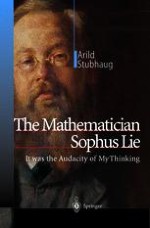2002 | OriginalPaper | Chapter
Into Mathematical History
Author : Arild Stubhaug
Published in: The Mathematician Sophus Lie
Publisher: Springer Berlin Heidelberg
Included in: Professional Book Archive
Activate our intelligent search to find suitable subject content or patents.
Select sections of text to find matching patents with Artificial Intelligence. powered by
Select sections of text to find additional relevant content using AI-assisted search. powered by
It was modern geometry that Sophus Lie now encountered with such fascination and zeal. This was an area within mathematics that stemmed mainly from Euclid’s two-thousand-year-old books, and a field that now, during the 1800s underwent a furious development. Outlooks and methods, both old and new were being combined together into integrated theories, and these theories developed and diverged more and more radically from what earlier had been understood as geometry — first and foremost perhaps as a liberation from a direct perception of the perceivable world. This modern geometry — called at the beginning astral or imaginary geometry — gradually came to be called non-Euclidean geometry. In many places during the course of the nineteenth century, it would come to engender oppositional reactions just as vehement as those that greeted Darwin’s Theory of Evolution. In England particularly, non-Euclidean geometry, Darwin, and ethical relativism were lumped together and said to represent those forces that were absolutely inimical to God. On the other hand, the theory of evolution and non-Euclidean geometry were manifestations of what, at the time, were radical new methods of thinking. Whereas established faith and methods of thinking tried to pack away every single phenomenon within one eternal framework — to define thought according to a single necessary formula, and explain human variation as a result of the existence of different types and stocks — the modern theories advanced conceptions about how scarcely anything could be seen, known or described in real, absolute terms: instead, everything must of necessity be seen and described according to known conditions, and therefore, in the final analysis, be relative. With that, the pivotal question arose about what it is that knowledge is really composed of, whether it be God-given or man-made.
